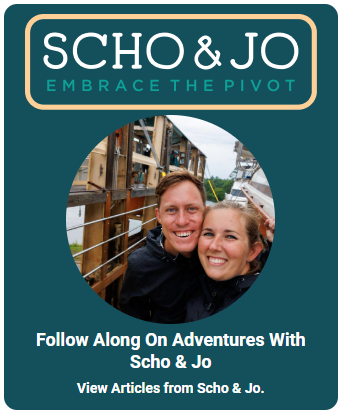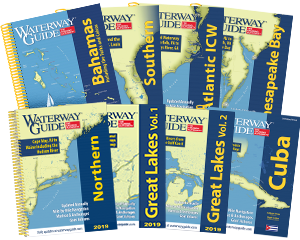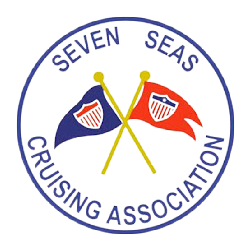For the past four years, my husband Matt and I have joined the legions of cruisers who travel I-95's watery cousin, the ICW. We point the bow of our 38' sailboat south in the fall, seeking warmer climes. And then we crawl our way back north in the spring to avoid summer hurricanes.
While the ICW is considered by many to be the highway that connects north and south, we like it for a different reason–it presents options. On our boat, the crew's comfort is one of the most important factors considered when planning trips. When the wind and seas are up, the weather is bitterly cold or everyone is a little tired, the ICW is the perfect leisure cruise. But sometimes, hopping outside for a quick overnight is just what the skipper ordered.
There are many reasons to choose an offshore nighttime trip. It can be an efficient way to make miles. It can help cruisers avoid bridge delays, sailors can shake out their sails and save some diesel and deep-draft vessels can avoid shoaling trouble spots along the ICW. Finally, traveling offshore at night is an achievable challenge that can increase your confidence in yourself, your boat and your crew. It's also an excellent way to start prepping for even longer passages.
Staying Out After Dark
For many boaters, their first overnight trip is a rite of passage. At first consideration, it seems like a bad idea. What about other boats moving around in the dark? What about those pesky aids to navigation (ATONS) that seem so helpful in the day but at night become weapons of doom, waiting to hole the boat? What about loose containers that may have fallen off ships and are bobbing about? What if you are not able to sleep on your off shift? What if someone falls overboard? What if, what if…?
Our first offshore overnight came about because we wanted to challenge ourselves and also for logistical reasons. Based in North Palm Beach, we wanted to get to Miami for a Christmas vacation, but we didn't want to spend days of precious vacation time getting there. Adding to the decision to make an offshore leap from Ft. Lauderdale to Miami was the fact that our mast wouldn't fit under the 55-foot vertical clearance Julia Tuttle Bridge. So, offshore and overnight it was.
I was nervous (okay, terrified). We went out of the inlet at sunset. Then it got dark…seriously, nighttime-on-the-ocean dark. We weren't even in the middle of the ocean. We had the gleaming lights of the South Florida shoreline the whole way. It was beautiful. Living in South Florida, I didn't normally get to see stars at night. But just a few miles offshore, you could see stars. We completed our watches. We napped in the salon. I listened to audiobooks. Chocolate was consumed. I was surprised at how early the day began to dawn. Then the sun rose and we were in Miami. Just like that.
It was the perfect first-time night sailing experience. Nothing broke, and we didn't hit anything. We were able to sail while avoiding South Florida's 34 bridges, constant boat traffic and the chance of being dismasted by the Julia Tuttle Bridge. All good things!
Equipment
We love having all the bells and whistles on board. Because we're full-time cruisers, our investment in both Automatic Identification System (AIS) and radar has paid off. If you're planning to do significant cruising, both can be great sources of comfort. My night vision isn't great, and I have a hard time determining the distance of lights. AIS is a massive help at night for monitoring big ship traffic. It shows vessel names, their sizes and the closest points of approach. If it looks concerning, you can call the vessel by name and make arrangements for a safe passage. (Calling "that huge ship near me" usually does not get a response.)
If there's one piece of equipment I wouldn't cruise without, it's radar. It shows objects like those 25-foot fishing boats that don't have AIS and unlit buoys and pilings and can help you identify landmarks for navigation. It can also help you navigate through rain and fog and even dodge those pesky summer thunderstorms.
Extra safety considerations are especially important at night. While it's important to stay onboard the boat in daylight hours, it's vital at night. If your crew is off watch and napping, they're not going to notice your departure from the boat. For this reason, wear a lifejacket with reflective strips and a safety strobe at all times, always use a tether when on deck and consider investing in a personal locator beacon (PLB) or (PAB if your boat has AIS). These pocket-sized man overboard (MOB) transmitters will help rescuers (or your crew) find you faster should the worst happen.
Watchkeeping & Safety
You'll want to set some rules of the ship for your own vessel and your crew. On our boat, no one goes on deck without first waking the off-watch crewmember. Everyone should have their vests and PLBs on and be tethered in at all times.
You'll want to customize a watch schedule that works for you. We are firm believers that someone should be at the helm actively looking for trouble at all times. The actual length of time we spend on and off watch varies considerably, depending on the time of day, how long the trip is, what the weather is doing and how each one of us is feeling. In general, our watches are 3 to 4 hours long, but there have been times we have stayed on for longer (or shorter) lengths of time. Most important is that you come up with a plan that works for you and that ensures the crew is well rested.
But how do you stay awake during your watch, and how do you sleep during your off watch? To keep myself alert, I like to listen to entertaining audiobooks or podcasts while scanning for other vessels. I continuously eat healthy snacks. There may also be a large stash of chocolate involved (you know, for emergencies). To sleep, I keep my regular nighttime habits. I always change into my pajamas and brush my teeth. A lee cloth can keep you secure in your bunk, and an eye mask can block any ambient light, sending your brain a signal that it's time to go to bed.
If you're prone to seasickness, it's essential to try any medication before you're in the middle of a passage. While at sea is not the time to find out about an unknown allergy or have a severe reaction to a new medication. When you've found something that works for you, start taking it before your trip so that it can be in your system and effective during the trip, when you really need it. Other things that can help avoid and mitigate seasickness include focusing on the horizon, eating ginger cookies and sticking with healthy foods. Caffeine, alcohol and fatty foods tend to make seasickness symptoms worse.
Whatever your reason for wanting to try an offshore nighttime passage, know that with the right equipment and planning, a careful eye on the weather, a good audiobook and maybe a stash of chocolate, a successful overnight passage is achievable. It may even turn out to be the highlight of your trip south.
Overnight Options
Where are best locations to try your first overnight passage? Below are some of our favorites along the ICW.
Chesapeake Bay–If you are in a hurry to head south (or north), an overnight passage through the Bay can get you to the ICW quickly and without spending hours each day arriving to and departing from anchorages in the tributaries along the Bay.
Cape Hatteras– With good weather, rounding the Cape is no big deal. There are no suitable inlets between Norfolk and Beaufort/Morehead City, NC, so make sure you have a great weather window and give the "Graveyard of the Atlantic" shoal areas a wide berth.
Onslow Bay–When heading south, depart Beaufort, NC, for Masonboro Inlet at Wrightsville Beach, NC. This is one of our favorite hops: It's only 60 miles with easy inlets and you avoid several bridges, some shoaling and the large Camp LeJeune restricted zone. Be sure to plan your departure and arrival for favorable tides at the inlets, which will often have swift currents!
Georgia–Unfortunately, the State of Georgia has a less than stellar reputation among cruisers. Besides the recent discussions on anchoring and boater restrictions, the state has enormous tides and troublesome shoaling spots. Luckily, if you'd like to make some miles, it's an easy trip from either Charleston or Beaufort, SC, to St. Mary's Inlet (the FL/GA state line).
South Florida-Between West Palm Beach and Miami, there are 34 bridges and nearly all have scheduled, restricted openings. Further, anyone with a 55-foot or taller mast must go outside to avoid Miami's fixed Julia Tuttle Bridge (the lowest bridge on the entire ICW).
The Bahamas–There are several good overnight hops to be made as you make your way east into the islands. Many choose to cross the Gulf Stream at night, mainly because crossing the Great Bahama Bank is too time-consuming to complete in daylight hours. This is described in detail in the Southern and Bahama editions of Waterway Guide.
Capts. Matt and Lucy Claiborne are the Waterway Guide's senior Bahamas cruising editors. They travel and live aboard their 38-foot Cabo Rico Dulcinea, spending winters in The Bahamas and summers exploring the East Coast.












